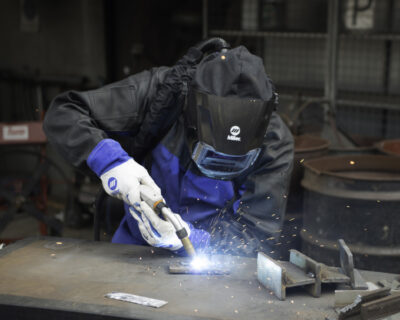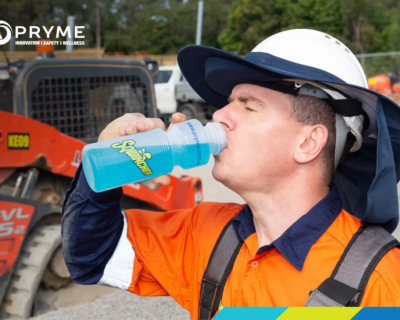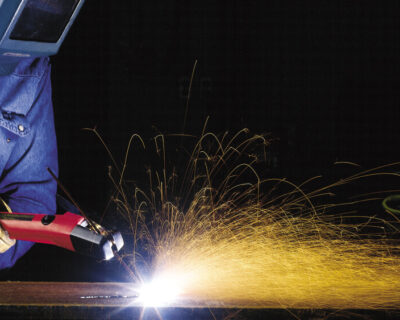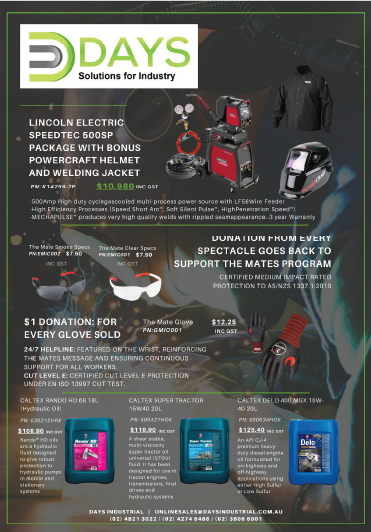Blog
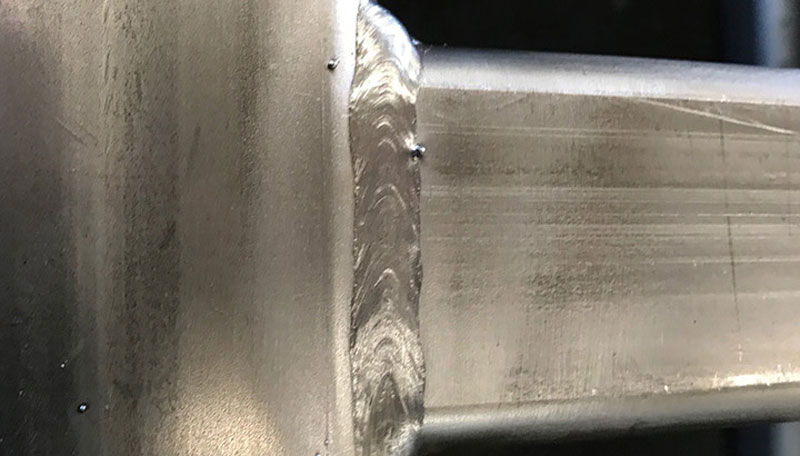
Want to Improve Results when MIG Welding Stainless Steel?
From material prep to choosing a shielding gas, learn how to reduce weld defects when MIG welding stainless steel.
MIG welding stainless steel
Stainless steel is ideal for welding applications that require long life and corrosion resistance – from fabricating fire pits and smokers to repairing damaged household items.
MIG welding stainless steel can provide benefits for efficiency while still producing high-quality welds, but it’s important to keep in mind some best practices.
Read below to learn some basics for MIG welding stainless steel.
Stainless steel characteristics
Stainless steel is corrosion resistant thanks to its added chromium content, which sets it apart from other materials. This makes it resistant to rust when it’s welded properly.
Stainless steel is also more sensitive to heat input than mild steel is. Too much heat for too long can result in carbide precipitation – which causes the material to lose its corrosion resistance. Another result of too much heat is oxidation on the back side of the weld joint. This makes it important to control the heat input, utilitse proper gas shielding, and maintain a good travel speed when welding stainless steel.
Additionally, stainless steel is a more expensive material than mild steel. Following some best practices can help reduce weld defects and distortion of the material and keep costs down.
Tips from a weld engineer
Here are seven tips for optimising results when MIG welding stainless steel:
- Choose the right shielding gas and filler metal
Too much carbon in the weld when working with stainless steel affects the material’s ability to resist corrosion. Therefore, it’s important to choose a shielding gas containing less than 5% carbon dioxide. A tri-mix gas of argon, helium and carbon dioxide is popular for MIG welding stainless steel. The specific mix of gases depends on what type of welding process you’re using. With a conventional MIG process, use a gas mix with more helium. With a pulsed MIG process, use a mix with more argon. You can also use a 98% argon and 2% carbon dioxide mix for welding stainless steel.To choose the proper filler metal, first determine which type of stainless steel you’re welding, since stainless comes in several varieties. Many alloys commonly used for stainless steel welding are designed to increase puddle fluidity. Some of the most common stainless steel base metals are 304 and 316. Some of the most common welding wires used with stainless steel are 309 and 316.
- Pay attention to preparation
When preparing stainless steel, use a stainless steel wire brush or stainless-dedicated grinding wheel for cleaning or grinding the metal. If you use a grinding wheel on mild steel and then use it on stainless steel, it will contaminate the stainless steel and could introduce weld defects or impurities. - Watch your technique and speed
Using a push technique will provide a better weld bead appearance and wetting of the puddle. Proper travel speed is important to help reduce the heat input into the base metal, so avoid slow travel speeds. Also, be cautious of using a weave motion with stainless steel, due to the amount of heat generated by this technique. - Adjust the arc control
A typical stainless steel weld can have what is referred to as a “ropey bead” compared to mild steel. Because of the surface tension of the weld puddle the bead likes to set up faster, which doesn’t allow it to flow to the edges of the weld. If you’re using a conventional MIG welding power source with adjustable arc control, increasing the arc control will help the puddle flow more. - Consider pulsed MIG
Pulsed MIG can deliver benefits, including less spatter and post-weld cleanup and a nice weld bead appearance. Pulsed MIG spray transfer mode can be a good option to help reduce heat input, which can be especially important on thin materials. It also provides the ability to weld out of position, which can’t be done with conventional CV MIG spray transfer because of the difficulty in controlling the fluid puddle. - Swap the drive rolls and liner
Be sure to use drive rolls and a MIG gun liner that are dedicated for stainless steel welding, rather than the same ones used to weld mild steel. This helps prevent cross contamination in the stainless steel weld. You can swap out the drive rolls and liner in the gun or have a separate welding gun dedicated to stainless steel welding. Also, because stainless steel filler metals are a bit harder than other types of filler metal, it can be difficult for V-groove drive rolls to get a good grip on the wire to feed it through the gun. Instead, try using V-knurled drive rolls with stainless steel. - Use post-flow gas coverage
It’s a good practice with stainless steel to use post-flow shielding gas coverage. Welders often use this technique in TIG welding, but it can be helpful when MIG welding stainless steel as well. Post-flow helps protect the weld as the weld pool solidifies and shields the puddle from atmospheric contamination as it cools. For proper post-flow, keep the gun nozzle close to the end of the weld for a half second to three seconds to ensure the shielding gas continues to flow back to the weld puddle as it solidifies.
Optimise stainless steel welds
Controlling heat input is a critical to maintaining stainless steel’s corrosion resistant properties and producing good welds. MIG welding stainless steel successfully also requires following best practices for choosing the right shielding gas and filler metal.


